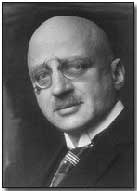Who's Who - Fritz Haber
 Fritz Haber (1868-1934) played a
prominent role in developing Germany's
chemical warfare
programme during World War One.
Fritz Haber (1868-1934) played a
prominent role in developing Germany's
chemical warfare
programme during World War One.
Haber was born in Breslau and studied from 1886-91 at the universities of Heidelberg and Berlin and at the Technical School at Charlottenberg.
Haber qualified as a private lecturer in 1896 with a thesis on his own experimental studies on the decomposition and combustion of hydrocarbons. Ten years later he was appointed Professor of Physical Chemistry and Electrochemistry and Director of the Institute at Karlsruhe set up to study these subjects.
Serving as Director of the Kaiser Wilhelm Institute for Physical Chemistry in Berlin from 1911-33, Haber willingly responded to a request from the German Army at the outbreak of war to investigate the possibility of substituting explosives in shells for poison gases.
Haber shortly thereafter oversaw trials with gas shells and soon recommended the use of such gas via manual release cylinders placed in the German front line, used to initial great effect during the Second Battle of Ypres in April 1915 (which he personally directed).
Beyond its initial usage at Ypres Haber, a dedicated patriot, played a prominent role in the remainder of Germany's wartime development of chemical weapons (to the horror of his wife, who eventually committed suicide, appalled at the nature of his work).
Immediately after the conclusion of the war Haber was awarded the Nobel Prize for chemistry (1918), a decision which met with significant opposition given his wartime activities but which was awarded for his pre-war work on the synthesisation of ammonia.
Of Jewish descent Haber was forced to flee from his homeland in 1933 (with nearly all his Institute staff having similarly to resign), seeking exile from the Nazi government's policies against Jews.
He accepted an invitation from Sir William Pope to live in Cambridge; after a few months there however he moved to Switzerland where he died the following year, having suffered from heart disease from years.
A 'Toasting Fork' was a bayonet, often used for the named purpose.
- Did you know?
